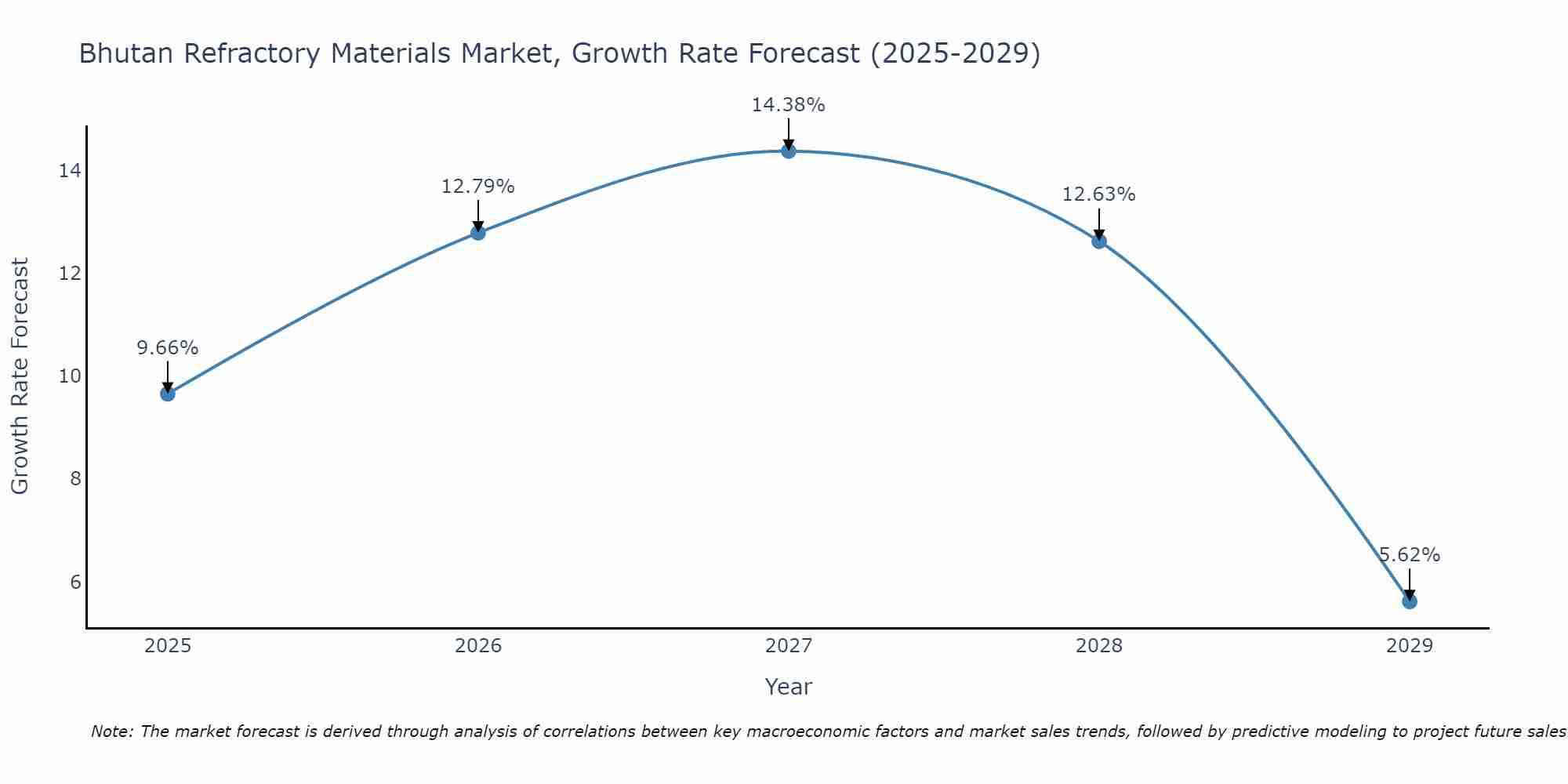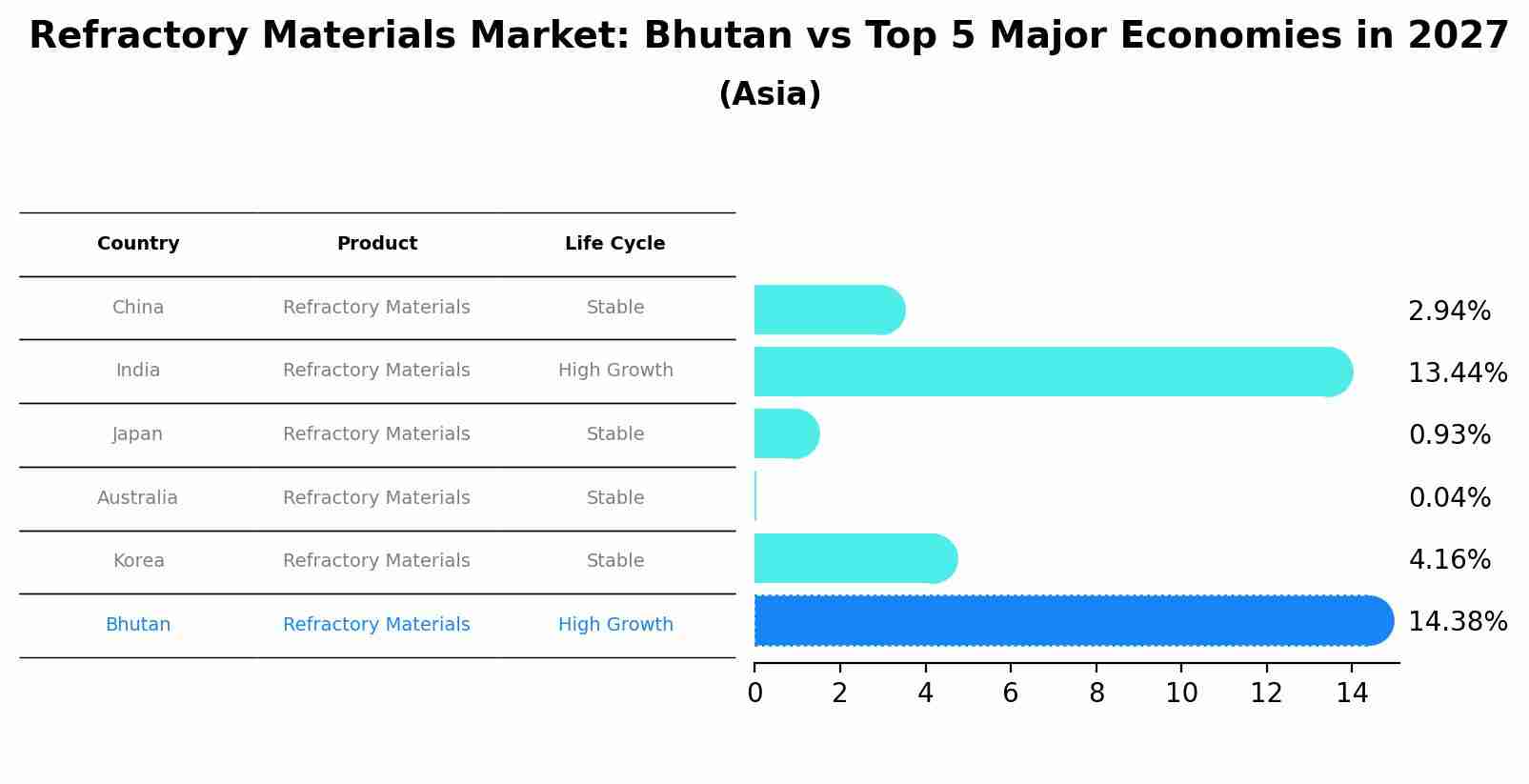Bhutan Refractory Materials Market (2025-2031) | Growth, Size, Revenue, Companies, Forecast, Value, Trends, Share, Outlook, Segmentation, Analysis & Industry
| Product Code: ETC5230896 | Publication Date: Nov 2023 | Updated Date: Sep 2025 | Product Type: Market Research Report | |
| Publisher: 6Wresearch | Author: Shubham Padhi | No. of Pages: 60 | No. of Figures: 30 | No. of Tables: 5 |
Bhutan Refractory Materials Market Size Growth Rate
The Bhutan Refractory Materials Market is projected to witness mixed growth rate patterns during 2025 to 2029. Growth accelerates to 14.38% in 2027, following an initial rate of 9.66%, before easing to 5.62% at the end of the period.

Refractory Materials Market: Bhutan vs Top 5 Major Economies in 2027 (Asia)
By 2027, the Refractory Materials market in Bhutan is anticipated to reach a growth rate of 14.38%, as part of an increasingly competitive Asia region, where China remains at the forefront, supported by India, Japan, Australia and South Korea, driving innovations and market adoption across sectors.

Key Highlights of the Report:
- Bhutan Refractory Materials Market Outlook
- Market Size of Bhutan Refractory Materials Market, 2024
- Forecast of Bhutan Refractory Materials Market, 2031
- Historical Data and Forecast of Bhutan Refractory Materials Revenues & Volume for the Period 2021-2031
- Bhutan Refractory Materials Market Trend Evolution
- Bhutan Refractory Materials Market Drivers and Challenges
- Bhutan Refractory Materials Price Trends
- Bhutan Refractory Materials Porter`s Five Forces
- Bhutan Refractory Materials Industry Life Cycle
- Historical Data and Forecast of Bhutan Refractory Materials Market Revenues & Volume By Type for the Period 2021-2031
- Historical Data and Forecast of Bhutan Refractory Materials Market Revenues & Volume By Brick for the Period 2021-2031
- Historical Data and Forecast of Bhutan Refractory Materials Market Revenues & Volume By Monolithic for the Period 2021-2031
- Historical Data and Forecast of Bhutan Refractory Materials Market Revenues & Volume By Applications for the Period 2021-2031
- Historical Data and Forecast of Bhutan Refractory Materials Market Revenues & Volume By Clay Refractories for the Period 2021-2031
- Historical Data and Forecast of Bhutan Refractory Materials Market Revenues & Volume By Non-clay Refractories for the Period 2021-2031
- Bhutan Refractory Materials Import Export Trade Statistics
- Market Opportunity Assessment By Type
- Market Opportunity Assessment By Applications
- Bhutan Refractory Materials Top Companies Market Share
- Bhutan Refractory Materials Competitive Benchmarking By Technical and Operational Parameters
- Bhutan Refractory Materials Company Profiles
- Bhutan Refractory Materials Key Strategic Recommendations
Frequently Asked Questions About the Market Study (FAQs):
1 Executive Summary |
2 Introduction |
2.1 Key Highlights of the Report |
2.2 Report Description |
2.3 Market Scope & Segmentation |
2.4 Research Methodology |
2.5 Assumptions |
3 Bhutan Refractory Materials Market Overview |
3.1 Bhutan Country Macro Economic Indicators |
3.2 Bhutan Refractory Materials Market Revenues & Volume, 2021 & 2031F |
3.3 Bhutan Refractory Materials Market - Industry Life Cycle |
3.4 Bhutan Refractory Materials Market - Porter's Five Forces |
3.5 Bhutan Refractory Materials Market Revenues & Volume Share, By Type, 2021 & 2031F |
3.6 Bhutan Refractory Materials Market Revenues & Volume Share, By Applications, 2021 & 2031F |
4 Bhutan Refractory Materials Market Dynamics |
4.1 Impact Analysis |
4.2 Market Drivers |
4.2.1 Growing industrialization and infrastructure development in Bhutan leading to increased demand for refractory materials. |
4.2.2 Rising focus on energy efficiency and sustainability driving the adoption of advanced refractory materials. |
4.2.3 Government initiatives and investments in sectors such as cement, steel, and glass, which are major users of refractory materials. |
4.3 Market Restraints |
4.3.1 Limited availability of raw materials for manufacturing refractory materials in Bhutan. |
4.3.2 High initial investment and maintenance costs associated with advanced refractory materials. |
4.3.3 Impact of global economic fluctuations on the demand for refractory materials in Bhutan. |
5 Bhutan Refractory Materials Market Trends |
6 Bhutan Refractory Materials Market Segmentations |
6.1 Bhutan Refractory Materials Market, By Type |
6.1.1 Overview and Analysis |
6.1.2 Bhutan Refractory Materials Market Revenues & Volume, By Brick, 2021-2031F |
6.1.3 Bhutan Refractory Materials Market Revenues & Volume, By Monolithic, 2021-2031F |
6.2 Bhutan Refractory Materials Market, By Applications |
6.2.1 Overview and Analysis |
6.2.2 Bhutan Refractory Materials Market Revenues & Volume, By Clay Refractories, 2021-2031F |
6.2.3 Bhutan Refractory Materials Market Revenues & Volume, By Non-clay Refractories, 2021-2031F |
7 Bhutan Refractory Materials Market Import-Export Trade Statistics |
7.1 Bhutan Refractory Materials Market Export to Major Countries |
7.2 Bhutan Refractory Materials Market Imports from Major Countries |
8 Bhutan Refractory Materials Market Key Performance Indicators |
8.1 Energy efficiency improvements achieved through the use of refractory materials. |
8.2 Adoption rate of advanced refractory materials in key industries. |
8.3 Number of government projects and investments supporting the refractory materials market in Bhutan. |
9 Bhutan Refractory Materials Market - Opportunity Assessment |
9.1 Bhutan Refractory Materials Market Opportunity Assessment, By Type, 2021 & 2031F |
9.2 Bhutan Refractory Materials Market Opportunity Assessment, By Applications, 2021 & 2031F |
10 Bhutan Refractory Materials Market - Competitive Landscape |
10.1 Bhutan Refractory Materials Market Revenue Share, By Companies, 2024 |
10.2 Bhutan Refractory Materials Market Competitive Benchmarking, By Operating and Technical Parameters |
11 Company Profiles |
12 Recommendations | 13 Disclaimer |
- Single User License$ 1,995
- Department License$ 2,400
- Site License$ 3,120
- Global License$ 3,795
Search
Thought Leadership and Analyst Meet
Our Clients
Related Reports
- Germany Breakfast Food Market (2026-2032) | Industry, Share, Growth, Size, Companies, Value, Analysis, Revenue, Trends, Forecast & Outlook
- Australia Briquette Market (2025-2031) | Growth, Size, Revenue, Forecast, Analysis, Trends, Value, Share, Industry & Companies
- Vietnam System Integrator Market (2025-2031) | Size, Companies, Analysis, Industry, Value, Forecast, Growth, Trends, Revenue & Share
- ASEAN and Thailand Brain Health Supplements Market (2025-2031) | Strategy, Consumer Insights, Analysis, Investment Trends, Opportunities, Growth, Size, Share, Industry, Revenue, Segments, Value, Segmentation, Supply, Forecast, Restraints, Outlook, Competition, Drivers, Trends, Demand, Pricing Analysis, Competitive, Strategic Insights, Companies, Challenges
- ASEAN Bearings Market (2025-2031) | Strategy, Consumer Insights, Analysis, Investment Trends, Opportunities, Growth, Size, Share, Industry, Revenue, Segments, Value, Segmentation, Supply, Forecast, Restraints, Outlook, Competition, Drivers, Trends, Demand, Pricing Analysis, Competitive, Strategic Insights, Companies, Challenges
- Europe Flooring Market (2025-2031) | Outlook, Share, Industry, Trends, Forecast, Companies, Revenue, Size, Analysis, Growth & Value
- Saudi Arabia Manlift Market (2025-2031) | Outlook, Size, Growth, Trends, Companies, Industry, Revenue, Value, Share, Forecast & Analysis
- Uganda Excavator, Crane, and Wheel Loaders Market (2025-2031) | Strategy, Consumer Insights, Analysis, Investment Trends, Opportunities, Growth, Size, Share, Industry, Revenue, Segments, Value, Segmentation, Supply, Forecast, Restraints, Outlook, Competition, Drivers, Trends, Demand, Pricing Analysis, Competitive, Strategic Insights, Companies, Challenges
- Rwanda Excavator, Crane, and Wheel Loaders Market (2025-2031) | Strategy, Consumer Insights, Analysis, Investment Trends, Opportunities, Growth, Size, Share, Industry, Revenue, Segments, Value, Segmentation, Supply, Forecast, Restraints, Outlook, Competition, Drivers, Trends, Demand, Pricing Analysis, Competitive, Strategic Insights, Companies, Challenges
- Kenya Excavator, Crane, and Wheel Loaders Market (2025-2031) | Strategy, Consumer Insights, Analysis, Investment Trends, Opportunities, Growth, Size, Share, Industry, Revenue, Segments, Value, Segmentation, Supply, Forecast, Restraints, Outlook, Competition, Drivers, Trends, Demand, Pricing Analysis, Competitive, Strategic Insights, Companies, Challenges
Industry Events and Analyst Meet
Whitepaper
- Middle East & Africa Commercial Security Market Click here to view more.
- Middle East & Africa Fire Safety Systems & Equipment Market Click here to view more.
- GCC Drone Market Click here to view more.
- Middle East Lighting Fixture Market Click here to view more.
- GCC Physical & Perimeter Security Market Click here to view more.
6WResearch In News
- Doha a strategic location for EV manufacturing hub: IPA Qatar
- Demand for luxury TVs surging in the GCC, says Samsung
- Empowering Growth: The Thriving Journey of Bangladesh’s Cable Industry
- Demand for luxury TVs surging in the GCC, says Samsung
- Video call with a traditional healer? Once unthinkable, it’s now common in South Africa
- Intelligent Buildings To Smooth GCC’s Path To Net Zero


















